Mark Sisson's Blog, page 26
April 29, 2022
New and Noteworthy: What I Read This Week—Edition 175

Research of the Week
Evolutionary trajectories of various traits in different European populations over the millennia.
A ketone body suppresses colorectal cancer.
Sunlight, strength training, and seafood are a powerful combo.
Beautifying filters and hireability.
Remote learning decreased learning.
New Primal Kitchen PodcastsPrimal Health Coach Radio: Dr. Anna Cabeca
Media, SchmediaLA bans plastic takeout containers.
Interesting Blog PostsWhat is brain fog, really?
Social Notes2% relative risk reduction for giving up meat. Terrible deal.
Everything ElseThe power of human excrement.
Things I’m Up to and Interested InOnce again we are right: Some cattle are better than none.
Speed saves: Walking pace and aging.
Interesting article: Everything in moderation or moderating everything?
More Interesting article: The myth of primitive communism.
Ever wonder?: Why we duel.
Question I’m AskingWhat’s your favorite animal and why?
Recipe CornerBrain pâté.Pea soup with prosciutto chips.Time CapsuleOne year ago (Apr 23 – Apr 29)
Maximum Sustained Power Training, or MSP— How to train it.Thank Goodness for Failure— It’s a gift.Comment of the Week
“Never grow up, never grow old.
We don’t slow down because we age, we age because we slow down.”
–Yes.
(function($) { $("#dflyxyz").load("https://www.marksdailyapple.com/wp-ad..." ); })( jQuery ); 
The post New and Noteworthy: What I Read This Week—Edition 175 appeared first on Mark's Daily Apple.


April 28, 2022
Easy Ways to Reduce Food Waste and Pitch in for the Planet

Experts estimate that people around the world waste 1.3 billion tons of food each year.1 The costs to individuals, families, and the environment are astronomical. You can make a difference by making a personal commitment to minimizing food waste.
At Mark’s Daily Apple, we’re joining Primal Kitchen in an effort to #MaketheMost of mealtime this National Food Waste Day. Scroll down to find tips and techniques for being more sustainable and reducing your environmental footprint by reducing food waste, optimizing your grocery budget, and contributing less to the landfill.
For more information, head to PrimalKitchen.com and sign up to receive an exclusive e-book to fight food waste with tasty recipes, packaging hacks, and more tips!
Store and Preserve Food Properly So It Doesn’t Go to Waste Food spoiling before you get a chance to eat it is a huge contributor to food waste. In additional to shopping smart (more on that below), you can nip this problem in the bud by storing food properly after you bring it home from the store.
Food spoiling before you get a chance to eat it is a huge contributor to food waste. In additional to shopping smart (more on that below), you can nip this problem in the bud by storing food properly after you bring it home from the store.
For those times when you buy a little too much or you’re lucky enough to have a bountiful garden harvest, learn how to preserve that food and enjoy it for months to come.
Avoid spoilage:
Vegetable Victory: How to Best Preserve ProduceWhen Do Foods Really Go Bad?Freeze:
How to Freeze ProduceFresh Versus Frozen Food: Which Is More Nutritious?Dehydrate:Dehydrating Food at Home: How to Get StartedEasy Camping Meals You Can Prepare at HomeHow to Make Your Own JerkyHow to Make Turkey Jerky (That’s Super Easy and Tastes Like Thanksgiving)Pickle and ferment:
Sauerkraut Benefits (with an Easy Homemade Sauerkraut Recipe)Pickled Vegetables, Two Ways: Home Fermented and Quick PicklesWhat to Do with Food Scraps: Trash to Treasure
Those food scraps aren’t trash! There’s still a lot you can do with them.
Turn them into compost: How to Start Composting
Make bone broth:
Chicken Bone Broth Four WaysBeef Bone Broth VariationsInstant Pot Chicken Bone Broth Recipe (with Stovetop Option)Get creative: The Many Uses of Junk Food
Eat Nose to Tail
 We know, those bits and bobbles can be a little off-putting at first, but organ meats are some of the most nutritious foods on the planet! Eating the skin and gristly bits nets you a bunch of collagen to balance out the methionine in muscle meat. The bones of small, oily fish contain calcium and other minerals. And best of all, almost nothing goes to waste.
We know, those bits and bobbles can be a little off-putting at first, but organ meats are some of the most nutritious foods on the planet! Eating the skin and gristly bits nets you a bunch of collagen to balance out the methionine in muscle meat. The bones of small, oily fish contain calcium and other minerals. And best of all, almost nothing goes to waste.
This is huge at a time when we’re fighting against a tide of anti-meat sentiment and claims that meat eating is bad for the environment. The best thing we meat consumers can do is advocate for and practice responsible omnivory or carnivory.
Get started with nose-to-tail eating:
Guide to Organ MeatsWhy We Should All Be Eating Organ MeatsHow to Eat More Organ MeatOrgan Meat Recipes6 Sneaky Ways to Work Offal Into Your DietLearn more about responsible farming and animal raising:
The Case For Better MeatHow to Eat Meat and Still Reduce Your Environmental ImpactPrimal Kitchen Podcast: Farming’s Future with Force of Nature Founders Robby & TaylorPrimal Kitchen Podcast: Pasturebird Founder Paul Greive Talks the Future of Farming & Regenerative PracticesSeasonal Eating and Locavorism
 One way to reduce your carbon footprint is to buy locally grown food when you can instead of food shipping across the country or around the world.
One way to reduce your carbon footprint is to buy locally grown food when you can instead of food shipping across the country or around the world.
Shopping at farmer’s markets not only supports local farmers and ranchers, but you also cut down on food packaging. Prioritizing locally grown produce also means you’ll naturally eat the foods that are in season in your region.
More information on seasonal eating:
Seasonal Eating: Getting the Most Out of Winter VegetablesSeasonal Eating: 9 Tasty Springtime RecipesThe Question of Seasonality in Human Health and NutritionThe Question of Seasonality in Fructose AvailabilitySeasonality, Climate, and DietShop Smart and Meal Plan
Planning a few days’ or a week’s worth of food can save money and cut down on food waste. A little leg work up front ensures you’re only buying what you need.
Here are some ideas to get you started:
90-Minute Low-Carb, Keto Meal Prep10 Freezer-Friendly MealsLazy Keto Meal Plan15-Minute Meal Prep: Keto Ground Beef Recipes7 Days, 7 Salads ChallengeMore grocery shopping tips:
Navigating the Grocery Store on a BudgetHow to Clean Out Your Kitchen and Go PrimalReduce, Reuse, Recycle
Don’t just toss those empty mayo jars. Upcycle them!
How to Create a Mason Jar Salad out of a Mayo JarRecycled DIY Greenhouse Garden & Mayo PlantersPrimal Kitchen Mayo Jar Upcycle: Holiday Terrarium (video)Take advantage of your local recycling program. Look on all food packages for what can be recycled or composted.
Small Steps Add Up to More Sustainability
Learn how to reduce food waste, cut down on your carbon footprint, and put less in the landfill. Small steps really do add up, especially when we all do our part.
Check out this post for lots of easy-to-implement ideas: Sustainable, Eco-friendly Kitchen Updates
Reducing food waste is something you can do at home that really does make a difference. Talk to your friends and family, and start implementing some of these practices. What do YOU do to reduce food waste?
References https://www.fao.org/3/my358en/my358en... (function($) { $("#df1Im5W").load("https://www.marksdailyapple.com/wp-ad..." ); })( jQuery ); 
The post Easy Ways to Reduce Food Waste and Pitch in for the Planet appeared first on Mark's Daily Apple.


April 27, 2022
Easy Camping Meals You Can Prepare at Home
 The weather turns, the clouds disperse, the sun returns, and one’s thoughts wander to camping, backpacking, and just generally tromping around in the great outdoors. It is the human imperative to conquer the wilderness and to exult in its grandeur, beauty, and danger. The true frontier is mostly gone now, but we can emulate that most fundamental and ancient human experience by going camping.
The weather turns, the clouds disperse, the sun returns, and one’s thoughts wander to camping, backpacking, and just generally tromping around in the great outdoors. It is the human imperative to conquer the wilderness and to exult in its grandeur, beauty, and danger. The true frontier is mostly gone now, but we can emulate that most fundamental and ancient human experience by going camping.
I’ve explained why camping is so important for your health and happiness:
It restores your circadian rhythm.
It encourages healthy movement outdoors.
It places fire at the center of the communal nighttime setting rather than TV or smartphones.
It’s fun.
But you gotta eat out there.
What to Eat in the Great Outdoors: Easy Camping MealsCamping meal ideas don’t have to be complicated. You can easily get by for a few days or even longer with a combination of:
Grain-free granolaJerky, biltong, pemmicanOlives or dried olivesNuts and nut butter (available in single-serve packets)Trail mix, spiced roasted nutsHard salami, summer sausageHard cheese, freeze-dried cheeseTuna packets or other tinned fish, canned oysters/musselsWhole avocadosWhole fruitsLow-carb protein barsLow-carb tortillas (or regular corn tortillas if you prefer)Cooked potatoes/sweet potatoes (which last for a few days at room temp)Hard boiled eggs (which last for a day or two depending on temperature)Dried fruits, dates, berries, figsIn fact, you can eat quite well this way. You can certainly survive.
But sometimes you want a bit more luxury. You want something hot and comforting. Rather than squat around the fire gnawing on dried meat and crunching nuts, you want to sit with your people with a warm bowl in front of you and have a proper meal, wilderness style
Yesterday, you learned how to dehydrate food. Check that out if you’re new to dehydrating. It’s easy and economical, but there are a few things you need to know to get started. Today, I’m going to give you a few recipes for dehydrated trail meals. This is trail food—not car camping food. This is stuff that’s lightweight, backpack-stable, and dehydrated. This is food you can carry with you for days.
Making Your Own Easy Dehydrated Camping MealsUnlike most commercial trail foods, these are nutrient-dense and delicious meals without any undesirable fats or ingredients. No industrial seed oils, plenty of animal protein.
There are a couple ways to make dehydrated camping meals:
You can make finished meals at home, dehydrate them, and heat them on the trail.You can make individual dehydrated ingredients and then mix and heat them together on the trail.I’ll describe below how to rehydrate food on the trail.
Scrambled eggsThis is almost as good as the real thing. Almost.
Add 1 part egg powder to 1.5 parts water, dried milk powder, and dried butter powder. (Ingredients readily available online or through a camping supply retailer.)Whisk it furiously. You want it totally blended, completely smooth, with lots of aeration.Heat oil or butter in a pan over medium-low heat. Add the egg mixture and any other rehydrated veggies you might have and stir continuously. Salt and season as you go.Finish with cheese if you have any.Pressure Cooker ChiliThis is a bare bones chili. It doesn’t have any beans, but you can add them if you like.
Place the leanest beef you can find (top round, London broil, 96% lean ground, etc) in the pressure cooker along with tomato paste, onions, garlic, peppers, chili powder, cumin, smoked paprika, and chipotle pepper (if you like spicy). Add enough bone broth to cover everything, then pressure cook until the meat is falling apart.Reduce the chili until most of the liquid is gone and it’s a thick stew rather than soup.Spread the chili in a thin layer and dehydrate it.The trick here is using liquid and pressure to cook it, rather than fat. When you rehydrate it on the trail, add plenty of fat.
Dehydrated mashed potatoes or sweet potatoesThese make an excellent base for any meal, particularly if you’ve been expending a lot of energy out on the trail.
Peel and boil your potatoes just like you would when making mashed potatoes.When they’re soft, drain them almost completely. Reserve a few cups of the cooking water.Mash them with as much water as needed to produce a thick “soupy” textured mash, wetter than normal.Add salt and spices if desired, or wait for the trail.Do not add any fat, milk, butter, or cream. You can add that on the trail after reconstitution.Spread into thin layer and dehydrate until dry and brittle. Break or grind up into powder and store.To reheat, mix half cup of dehydrated potato with 2/3 cup boiling water. Cover for 5-10 minutes and add any milk, butter, cheese, or seasonings. Adjust texture by adding more water if you want.
This also works for cauliflower. Just be sure not to add any fat until you’re rehydrating it on the trail.
These are just a few ideas. You can do a lot of cool stuff out there if you stick to the basics and follow some fundamental rules.
Some TipsUse as little fat as possible.The thing about cooking and dehydrating your own meals for the trail is that you have to go about it a little differently. You can’t use a ton of fat when you cook because fat simply doesn’t dehydrate very well. The whole point of dehydrating is to remove moisture and end up with a final product that stays shelf-stable at room temperature for a long time. Too much fat will retain moisture and go rancid.
So when you’re looking at these recipes, they might seem a little funny. When I make my normal camp chili, I’m searing the meat and veggies in butter and olive oil and really making a rich, thick stew—but that doesn’t fly when you’re dehydrating chili. You can always add the fat afterwards, after the dehydrated meal has been heated up, and I’ll include a list of essential additions to bring along when you head out into the wilderness for enriching your meals.
Use lower fat meat.When you use beef, go as lean as you can. When you cook chicken, use breast or canned chicken.
Use liquid.Since you can’t really use tons of fat when cooking meals for dehydration, you’ll need to include a good amount of liquid to prevent sticking. Dehydration will take care of the moisture, of course.
Important Additions to Add to Your PackThese are the cooking ingredients I consider essential for anyone eating well on the trail.
Gelatin powder/bone broth powderHeat some water on the camp stove and whisk this stuff into it, then pour the gelatin-rich liquid into your soups, stews, chilis, and sauces to add texture, body, and gelatin.
Butter powder (yes, actual powdered grass-fed butter)Add butter powder to any low-fat dish to enrich and render it more luxurious. You could also just bring real butter if there’s room, it’s not too hot out, and it won’t throw off your backpack weight.
Olive oil or avocado oil in small bottlesThis is a great bottle (BPA-free, made in the USA) for storing edible oil to drizzle over your food. This is a good olive oil and this is a good avocado oil.
Powdered eggs and yolksPowdered eggs and powdered egg yolks are excellent to have on hand for quick breakfasts or to fortify other dishes.
Milk powderMilk powder is another good addition to have on hand.
Cheese powder or cheeseCheese powder is a nice way to add body and nutrition to almost any dish. You could also pack straight-up hard cheese, which lasts quite well at room temperature. Shelf-stable grated cheese is also an option.
Salt, pepper, spicesAt the very least, bring salt, black pepper, and something like garlic powder, paprika, porcini powder, or cayenne. Very easy, very simple, very effective seasoning.
Sun-dried tomatoesSun-dried tomatoes provide umami, acidity, sweetness, and that burst of rich tomato flavor that enriches almost any dish it touches. You can also snack on them directly.
MayoYes, yes, it’s not essential, but if you have the room, keeping some mayo on hand will really enhance your meals.
How to Rehydrate Your Dehydrated MealsThis is quite simple.
Heat water until simmering in camp stove and add your meal. Usually it’s about 1 part dehydrated meal to 1.5 parts water.Cover and heat until it reaches the desired consistency.Adorn your meal with any spices, seasonings, oil, fat, and cheese.Different dishes will have different rehydration requirements, but that’s the basic formula. If you’re just guessing, use less water than you think. You can always add more.
I’d love to hear what you guys are dehydrating and rehydrating out there on the trail. Let me know down below what your favorite dehydrated backpacking dishes are to make and eat!
(function($) { $("#df5QF8X").load("https://www.marksdailyapple.com/wp-ad..." ); })( jQuery );
The post Easy Camping Meals You Can Prepare at Home appeared first on Mark's Daily Apple.


April 26, 2022
Dehydrating Food at Home: How to Get Started
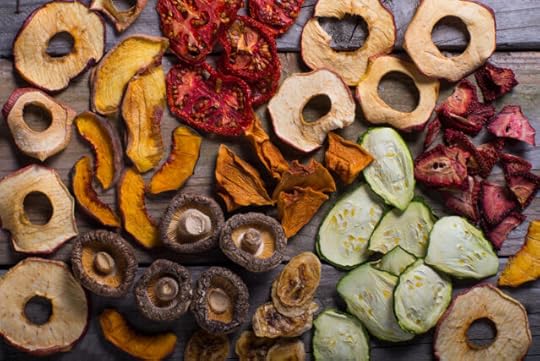 It’s easy to see why food preservation would have been critical to our ancestors’ survival. Being able to store food to eat later meant they were protected against unsuccessful hunts and less-than-fruitful gathering. Moreover, they could migrate into regions where access to fresh food varied by season.
It’s easy to see why food preservation would have been critical to our ancestors’ survival. Being able to store food to eat later meant they were protected against unsuccessful hunts and less-than-fruitful gathering. Moreover, they could migrate into regions where access to fresh food varied by season.
Drying was probably one of the earliest methods of food preservation paleolithic humans discovered, no doubt quite by accident. There’s evidence that our ancestors were drying food to preserve it as early as 10,000 to 12,000 BCE.https://www.google.com/books/edition/... https://nchfp.uga.edu/publications/nc... Along the way, they also learned how to ferment, smoke, and use ash, salt, fat, and even peat bogs to keep food from spoiling. Each of these methods works in its own way by discouraging the growth of microorganisms that cause food to go bad. In the case of dehydrating, microbes require water to proliferate. No water, no rotting.
As food preservation methods go, drying, or dehydrating, has several advantages. Dehydrated food is shelf-stable and lightweight, making it a space-efficient and energy-efficient option—no refrigeration required. It’s perfect for homesteaders, parents, hikers, and backpackers who want to make portable, healthy snacks and meals to reconstitute later.
For DIYers, dehydrating is a great way to get started with home-preserving. It’s simpler than canning or fermenting (although those are easy to learn, too, so don’t be intimidated). Here are the basics to help you get started.
Methods of Dehydrating FoodBy far, the most foolproof way to dry food is with a countertop dehydrator. Dehydrators work by using a combination of low heat and air circulation to remove moisture. An inexpensive dehydrator only costs about 40 dollars (USD), but you can spend ten times that or more on a top-tier model.
If you don’t want to invest in yet another kitchen appliance, however, you have options:
Sun is nature’s food dehydrator. This is what our ancestors used, after all. Sun drying works best in hot climates with low humidity. Food safety experts only recommend sun drying for fruit and herbs. Vegetables don’t have enough naturally occurring acid or sugar, both of which help resist molding and spoiling.A related method is air drying, which doesn’t involve direct sunlight. Think bundles of herbs or hot peppers hanging from the rafters to dry. This method also requires low humidity and good airflow. Air drying is the preferred method for some types of dried meat like biltong.Use your oven. This isn’t the best method because most ovens don’t have a low enough heat setting. The recommended temperature for dehydrating food is 140 degrees Fahrenheit (60 degrees Celsius), but a typical oven won’t go below 170 degrees. Ovens also don’t circulate air unless they have a convection setting. Still, you can make it work in a pinch, but you have to pay attention to avoid cooking your food instead of drying it.Choosing a Food DehydratorOverall, food dehydrator appliances will deliver the most consistent results, and they’re suitable for all types of food. If you’re thinking about making your own snacks or backpacking meals, it’s worth picking one up.
Besides price, you’ll also want to consider size and materials. Many dehydrators use plastic trays, but you can pay more for stainless steel. Alternately, you can purchase inexpensive silicone mats or use parchment paper to prevent your food from touching the plastic trays if that’s something you care about.
You might also want to pay more for a model that offers different temperature settings. Although you can dehydrate pretty much anything at 140 degrees Fahrenheit, you may find you get better results with slightly cooler temperatures for herbs and vegetables and warmer temperatures for meat and seafood.
What Are the Best Foods to Dehydrate? Anything You Can’t Dehydrate?You can dehydrate just about anything, but fruits, vegetables, herbs, and meat are the most common for home-drying. Legumes and grains are also dry-able, but that’s probably not a big selling point for Primal folks. Dried legumes are already readily available, anyway.
Foods that don’t dehydrate well are those that contain a lot of fat:
Fatty meatsAvocadosDairy products*Nut buttersOlives (When you see dried olives, they’re usually salt-cured and/or preserved in oil, not just dried in the traditional sense.)*For backpacking meals or stocking your pantry, purchase commercially dried and pasteurized milk, cream, buttermilk, butter, and cheese powders. Dairy-free folks can look for dried coconut milk powder instead.
Eggs can be dehydrated at home, but salmonella is a concern. Because egg powder is also readily available online or at camping supply stores, this is another one I recommend purchasing.
And did you know you can also dehydrate dairy-free, egg-free, low-fat sauces? Great news for those of you who can’t imagine backpacking without your favorite ketchup to put on your scrambled eggs! Make “ketchup leather” to throw in your pack, and you’re good to go.
Dehydrating Food How-tosWhere to Start: Dehydrating BasicsThe whole point of drying is to discourage bacteria and mold, so make sure to start with clean food, utensils, and work surfaces.
Optionally peel fruits and vegetables, then remove any damaged or bruised spots. Slice produce and meat into thin, uniform slices no more than ¼-inch thick (about 6 mm), or dice produce small. Either way, keep the pieces as consistent as possible to ensure even drying.
Place food in a single layer on the dehydrator trays. While you can put more than one type of food into a dehydrator at one time, keep them separated so that you can take them out at different times depending on how quickly they dry.
Make sure you remove as much moisture as possible without cooking or overdrying the food. Be patient. Dehydrating takes anywhere from a few hours for something delicate like kale chips to 24 hours or more for jerky or dehydrated bone broth.
Once your food is fully dried, let it cool for about an hour, then transfer it to an appropriate container.
Below are tips for drying different types of foods. I recommend looking up instructions the first time you dehydrate something new to double-check technique and timing. Note that these guidelines assume that you’re going to be consuming your dried food within a matter of months. If you’re stocking up for the apocalypse, you’ll need to follow additional steps to prepare your food for longer-term storage.
How to Dehydrate VegetablesBefore drying vegetables, blanching is recommended to preserve flavor and texture. This involves briefly exposing the vegetables to hot water or steam to deactivate enzymes that lead to spoilage. This step is not necessary if you are starting with frozen vegetables, as they were blanched before freezing.
After blanching, dry the vegetables using a clean towel. Optionally season them at this time—if you’re making kale or zucchini chips, for example—but use a light hand since flavors get concentrated during dehydrating.
Table 2 here offers recommended times for blanching and dehydrating various types of vegetables. You’ll know your dried vegetables are ready when they become very crisp and you can easily snap them.
Make homemade greens powder: Dehydration is a fantastic way to use up spinach, kale, or chard, plus greens that might otherwise go to waste such as carrot tops, beet greens, and broccoli leaves. Thoroughly dehydrate and cool the greens, then blitz them in a blender or food processor. Store the powder in a jar and add it to smoothies, soups, and baked goods.
How to Make Dried FruitFor best results, pretreat fruit with a quick dip in an ascorbic acid (vitamin C) solution. Pick up vitamin C capsules at any store and mix 1 teaspoon of ascorbic acid powder per 2 cups of water. (One teaspoon equals six 500mg capsules.) Soak fruit for 3 to 5 minutes, then drain, dry, and dehydrate. A similar method using a sulfite dip is recommended for long-term storage.
Fruit can take anywhere from 6 hours to 48 hours to dry depending on the size and type of fruit. You’ll know it is dry when it becomes tough and leathery. Dried fruit won’t become brittle like dried vegetables.
Dried fruit needs to be conditioned before storage. This extra step helps distribute any leftover moisture evenly between the pieces of fruit to deter molding. Place the cooled dried fruit into large glass containers, leaving some space at the top. Set the containers in a warm, dry place, and give them a shake once or twice per day to keep the fruit from sticking together. If you notice any condensation in the container, the fruit needs to be dehydrated further. After a week, it will be ready to store.
Make fruit leather: Blend your fruit(s) of choice into a puree with a squeeze of lemon juice to preserve the color. You’ll need solid plastic or silicone tray liners to dehydrate the puree. Pour the puree into a thin layer and spread it as evenly as possible. Dehydrate until you can touch the fruit leather without leaving a dent. It will still be sticky.
How to Make Dried Meat and Beef JerkyDrying meat is a little finickier, so I definitely recommend following a recipe, but here are some things you need to know to get started:
Start with lean cuts of meat and trim off as much visible fat as possible. Slice meat thinly.The USDA recommends precooking meat to 160 degrees Fahrenheit (71 degrees Celsius) before drying to reduce E. coli risk.https://extension.colostate.edu/docs/... For max flavor, marinate the meat before drying.For poultry or fish, it’s easiest to start with canned options, which are already precooked. Otherwise, cook thoroughly before drying.You can dehydrate cooked ground beef or turkey, but typically you’d add breadcrumbs to keep the meat from becoming too hard. A Primal-friendly option is to use gluten-free breadcrumbs.Dehydrate meats at 145 degrees Fahrenheit (63 degrees Celsius). Depending on the thickness and type of meat, this could take anywhere from 6 to 12 hours or longer.In addition to the drying methods offered above, I’ve seen recipes for making jerky in an air fryer. I haven’t tried this myself, but I’m interested to know if it works. Leave a comment if you’ve tried it.
Drying HerbsHerbs are quick and easy to dry in a dehydrator. They don’t require any special prep except a quick wash. Removing the leaves from the stems isn’t necessary, but you can if you want.
If your dehydrator has different settings, use a lower temperature for herbs, ideally between 95 and 125 degrees Fahrenheit (35 to 50 degrees Celsius). They’ll only take a few hours to dry.
Yes, You Can Dehydrate Bone Broth!If you’re starting with homemade broth, cool it first and remove any excess fat from the top.
Place the broth in a saucepan and boil it down until it becomes the consistency of gravy. Transfer it to the dehydrator using silicone sheets, like when making fruit leather. Spread it into a thin, even layer, then dehydrate. Because you’re starting with something so wet, it can take two or three days, or even longer, to dry completely. Check it periodically to smooth out any thicker spots, and optionally flip it once it is solid enough to handle.
Once it’s fully dried and cooled, use a high-speed blender or food processor to grind it into the consistency of coarsely ground coffee, then store in a jar in the freezer.
How to Store Dehydrated FoodOnce your food is dried and cooled, it’s time to store it. The name of the game is keeping air and moisture out. You can do that with food-safe silicone bags, mason jars, metal cans, vacuum sealers, and so on.
According to the National Center for Home Food Preservation, dried foods should be used within four months to a year.https://nchfp.uga.edu/how/dry/pack_st... I’m aware that many homesteaders and survivalists store theirs for years—sometimes a decade or more. That’s probably safe under ideal conditions (food is properly pretreated, dehydrated, and stored in airtight containers at cold or moderate temperatures). Researchers at BYU say, for example, that dried apples stored in airtight cans or foil pouches with an oxygen absorber can last 15 to 30 years.https://womensconference.ce.byu.edu/s...
Do your own research here, but whatever you do, don’t mess around with meat. The USDA states that homemade jerky is only good for one or two months.https://www.fsis.usda.gov/food-safety... Commercially made jerkies stay fresh for up to a year, and canned meats will keep much longer.
To extend your dried food’s shelf life even more, stick it in the freezer. As with any frozen foods, make sure everything is tightly sealed in freezer-proof wrapping or containers, as trapped air leads to freezer burn.
For long-term storage, you can also purchase desiccant packs—you know, those little paper packets that come in your store-bought beef jerky and say “do not eat.” They are usually filled with non-toxic silica gel that absorbs some of the remaining moisture. Preppers and survivalists apparently store food in mylar bags with desiccants for many years with no issues. That’s beyond what we’re discussing today, but desiccants can be useful for extending your dried food’s shelf life even if you’re not stocking a bunker.
Just Try It!Now that you know the basics, give it a try for yourself. The National Center for Home Food Preservation is a great resource for beginners. Start with one or two simple items like dried apple slices or kale chips. Once you get the hang of it, you’ll want to start preserving all that extra produce from your garden or CSA box.
Let us know in the comments what your favorite thing to dehydrate is. Favorite appliance? Any foods we simply must try dehydrating?
Dehydrating Food FAQsIs dehydrated food as nutritious as fresh food?Evidence suggests that, similar to freezing, dehydrating largely maintains the nutritional value of the original fresh food, with a few minor differences here and there. It may even improve the bioavailability of certain nutrients.https://pubmed.ncbi.nlm.nih.gov/17995... Drying does concentrate any sugars, though, so pay attention if you’re counting calories or carbohydrates.
What are the best foods to dehydrate? Worst foods to dehydrate?You can dehydrate most foods: fruits, vegetables, meat, poultry, seafood, nuts, legumes, grains, and even things like bone broth, ketchup, and marinara sauce. Fatty foods aren’t suitable for drying at home because the fat will become rancid. These include fatty meats, avocado, nut butter, olives, and dairy products.
How does a dehydrator work?Dehydrators work by using low heat and circulating air to remove moisture from food without cooking it. Moisture allows harmful microorganisms to grow and cause the food to spoil. Removing the moisture causes those microorganisms to go dormant so food stays fresher longer.
How long does dehydrated food last?The answer depends on the type of food and storage method. Dehydrated fruits and vegetables will last from four months to a year, while homemade beef jerky should be eaten within a month or two. They all last much longer when you keep them in the freezer.
References https://www.google.com/books/edition/Pickled_Potted_and_Canned/pNxLRqSreGkChttps://nchfp.uga.edu/publications/nchfp/factsheets/food_pres_hist.htmlhttps://extension.colostate.edu/docs/pubs/foodnut/09311.pdfhttps://nchfp.uga.edu/how/dry/pack_store.htmhttps://womensconference.ce.byu.edu/sites/womensconference.ce.byu.edu/files/52a_2.pdfhttps://www.fsis.usda.gov/food-safety/safe-food-handling-and-preparation/meat/jerkyhttps://pubmed.ncbi.nlm.nih.gov/17995848/ (function($) { $("#dfCNj8S").load("https://www.marksdailyapple.com/wp-ad..." ); })( jQuery );
The post Dehydrating Food at Home: How to Get Started appeared first on Mark's Daily Apple.


April 25, 2022
Chinese Five Spice Baked Pork Chops with Sautéed Escarole
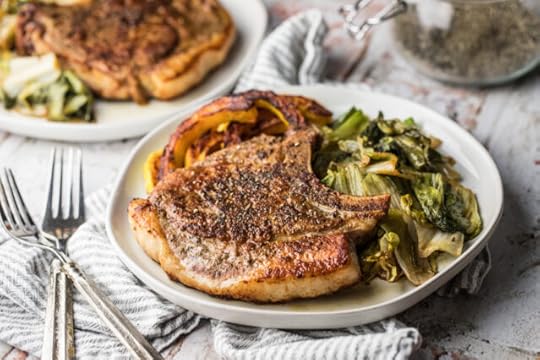 This recipe for baked pork chops seasoned with Chinese five spice powder and served with sautéed escarole is a fantastic way to add some flavor to your usual dinnertime meal while still keeping it quick and easy!
This recipe for baked pork chops seasoned with Chinese five spice powder and served with sautéed escarole is a fantastic way to add some flavor to your usual dinnertime meal while still keeping it quick and easy!
If you’re not familiar with these ingredients, Chinese five spice powder is a blend of—you guessed it—five different spices: star anise, fennel seeds, peppercorns (traditionally Szechuan peppercorns), cloves, and cinnamon. It really punches up these pork chops, giving them both a little heat and a sweet aromatic flavor.
You might know escarole as a salad green, but like most greens, it’s capable of so much more than that. In this recipe, a hint of vinegar, a pat of butter, and a scant drizzle of maple syrup turn escarole into a warm side dish that’s perfect with pork. It’s a bold medley of sweet, salty, and pleasantly bitter flavors. The bitter flavor of escarole can be a “love it” or “hate it” thing. This recipe is meant to woo the haters and please those who enjoy escarole’s natural bitterness.
A very large head of escarole wilts down to four small servings when cooked. Plan to serve another side with the meal, or, if you really love escarole, cook two heads instead of one.
Chinese Five Spice Baked Pork Chops with Sautéed Escarole RecipeServes: 4
Time in the Kitchen: 35 minutes
Ingredients:
1 Tbsp Primal Kitchen Avocado Oil2 bone-in pork chops with fat cap, about 1” thick¾ tsp Chinese five spice powder½ tsp salt¼ tsp black pepper1 head escarole, chopped and washed well1 Tbsp coconut aminos1 Tbsp butter2 tsp apple cider vinegar1-2 tsp maple syrup

Instructions:
Preheat your oven to 375 degrees Fahrenheit (190 degrees Celsius).
Sprinkle the five spice powder, salt, and pepper on both sides of the pork chops.
Heat an oven-safe skillet on your stovetop over medium-high heat. If your pork chops have a nice fat cap, place the pork chops in the pan sticking straight up with fat touching the pan. This will render some of the fat into the pan, which you can use to sear the chops. Otherwise, heat the avocado oil in the pan.
Once hot, place the pork chops in the pan and sear for 2 to 3 minutes until browned. Flip over and repeat on the other side.
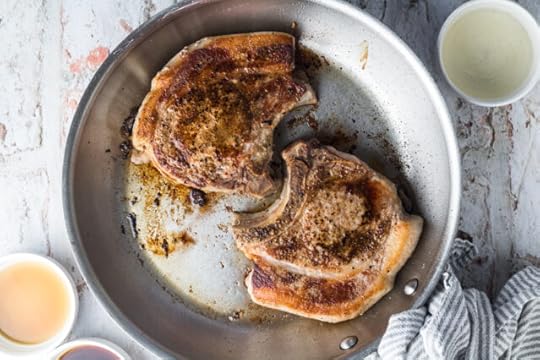
Place the pan in the oven and let the pork chops bake until they reach an internal temperature of 145 degrees Fahrenheit (62 degrees Celsius). Transfer the pork chops to a rimmed plate, pour half of the pan juices on top of the pork, and set aside.
Heat the pan again over medium-high heat. Add the vinegar and scrape up any browned bits on the bottom of the pan. When the vinegar begins to bubble and starts to evaporate, add the butter. Once the butter is melted, add the coconut aminos and maple syrup. Stir until combined, then add the escarole.

Sauté the escarole for a few minutes, until the leaves are tender. Avoid overcooking the escarole because it can develop a slimy texture when cooked for too long. Season with salt and pepper to taste.
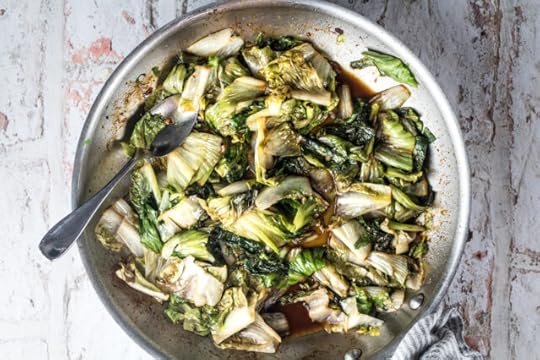
Serve the pork chops alongside the escarole and your favorite root veggie, like roasted delicata squash.

Nutritional Information (1/4 of recipe):
Calories: 288
Fat: 22 g
Total Carbs: 2 g
Net Carbs: 1 g
Protein: 20 g
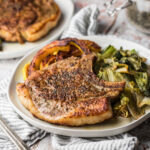 Chinese Five Spice Baked Pork Chops with Sautéed Escarole Author: Mark's Daily Apple
Chinese Five Spice Baked Pork Chops with Sautéed Escarole Author: Mark's Daily Apple  Total Time: 35 minutes
Total Time: 35 minutes  Yield: 4 servings Diet: Gluten Free [image error] Print Recipe [image error] Pin Recipe Description
Yield: 4 servings Diet: Gluten Free [image error] Print Recipe [image error] Pin Recipe Description Baked pork chops seasoned with Chinese five spice powder and served with sautéed escarole add fantastic flavor to your usual dinnertime meal while still keeping it quick and easy!
Ingredients1 Tbsp Primal Kitchen Avocado Oil
2 bone-in pork chops with fat cap, about 1” thick
¾ tsp Chinese five spice powder
½ tsp salt
¼ tsp black pepper
1 head escarole, chopped and washed well
1 Tbsp coconut aminos
1 Tbsp butter
2 tsp apple cider vinegar
1–2 tsp maple syrup
Preheat your oven to 375 degrees Fahrenheit (190 degrees Celsius).
Sprinkle the five spice powder, salt, and pepper on both sides of the pork chops.
Heat an oven-safe skillet on your stovetop over medium-high heat. If your pork chops have a nice fat cap, place the pork chops in the pan sticking straight up with fat touching the pan. This will render some of the fat into the pan, which you can use to sear the chops. Otherwise, heat the avocado oil in the pan.
Once hot, place the pork chops in the pan and sear for 2 to 3 minutes until browned. Flip over and repeat on the other side.
Place the pan in the oven and let the pork chops bake until they reach an internal temperature of 145 degrees Fahrenheit (62 degrees Celsius). Transfer the pork chops to a rimmed plate, pour half of the pan juices on top of the pork, and set aside.
Heat the pan again over medium-high heat. Add the vinegar and scrape up any browned bits on the bottom of the pan. When the vinegar begins to bubble and starts to evaporate, add the butter. Once the butter is melted, add the coconut aminos and maple syrup. Stir until combined, then add the escarole.
Sauté the escarole for a few minutes, until the leaves are tender. Avoid overcooking the escarole because it can develop a slimy texture when cooked for too long. Season with salt and pepper to taste.
Serve the pork chops alongside the escarole and your favorite root veggie, like roasted delicata squash.
 Prep Time: 5 minutes
Prep Time: 5 minutes Cook Time: 30 minutes
Cook Time: 30 minutes Category: Main dish Nutrition Serving Size: 1/4 of recipe Calories: 288 Sugar: 1g Sodium: 571mg Fat: 22g Saturated Fat: 8g Trans Fat: 0g Carbohydrates: 2g Fiber: 1g Protein: 20g Cholesterol: 73mg Net Carbs: 1g
Category: Main dish Nutrition Serving Size: 1/4 of recipe Calories: 288 Sugar: 1g Sodium: 571mg Fat: 22g Saturated Fat: 8g Trans Fat: 0g Carbohydrates: 2g Fiber: 1g Protein: 20g Cholesterol: 73mg Net Carbs: 1g Keywords: Baked pork chops, Escarole, Five spice pork chops
 Did you make this recipe?
Did you make this recipe? Share a photo and tag Mark's Daily Apple — we can't wait to see what you've made!
(function($) { $("#dfwLnvC").load("https://www.marksdailyapple.com/wp-ad..." ); })( jQuery );
The post Chinese Five Spice Baked Pork Chops with Sautéed Escarole appeared first on Mark's Daily Apple.


April 22, 2022
New and Noteworthy: What I Read This Week—Edition 174

Research of the Week
Less meat, more anxiety.
Breathing right is anti-viral.
Time restricted feeding increases locomotion.
BMI and mortality in the elderly.
Population and dietary changes in ancient Sicily.
New Primal Kitchen PodcastsPrimal Kitchen Podcast, Episode 27: Farming’s Future with Force of Nature Founders Robby and Taylor
Primal Health Coach Radio: John Berardi
Media, SchmediaTexas troopers face body composition requirements.
So whole milk isn’t allowed but strawberry milk is just fine (unless it’s Vegan Friday).
Interesting Blog PostsBeware of “evidence-based” preschool.
Steak-based diet. What do you think?
Social NotesEverything ElseCheese is not like heroin.
Geologic catastrophes preserved through ancient oral traditions.
Things I’m Up to and Interested InInteresting: Inflammation isn’t always a problem.
The more things change…: Great Atlantic article from the 1800s could have been written yesterday.
Interesting article: Time restricted eating “doesn’t work.” Will expand later.
Important question: Do statins really work?
Troubling: Mysterious hepatitis on the rise in children.
Question I’m AskingWhat’s the story of your life?
Recipe CornerProsciutto chips.Crispy chicken skins.Time CapsuleOne year ago (Apr 16 – Apr 22)
8 Aerobic Workouts That Aren’t Running, Cycling, or Swimming— What else to do.Sustainable, Eco-Friendly Kitchen Updates— Good updates.Comment of the Week
“That dog food study was, indeed, infuriating. The craziest part was that dogs eating a raw meat diet fared better than those on the vegan diet, but the researchers decided to conclude that the vegan diet was better anyway.”
-Absurd stuff, Karen.
(function($) { $("#dfVKHQi").load("https://www.marksdailyapple.com/wp-ad..." ); })( jQuery ); 
The post New and Noteworthy: What I Read This Week—Edition 174 appeared first on Mark's Daily Apple.


April 21, 2022
Ask a Health Coach: Is Cannabis Primal?
Hey folks, Board-Certified Health Coach Chloe Maleski is here to answer your questions about cannabis. Whether you’re wondering if it’s Primal, thinking of experimenting, or trying to cut back, you’ll learn important considerations to keep in mind. Got a question you’d like to ask our health coaches? Leave it below in the comments or over in the Mark’s Daily Apple Facebook group.
Julie asked:
“I never thought I’d be asking this, but is weed Primal? Is it addictive? I’m a 45-year-old mom of two and ‘partying’ means Netflix in bed. But my state legalized cannabis, and I’m curious to try it. Bad idea or no big deal?”
 You’re not alone in asking this, Julie! As laws around cannabis use change, folks who may not have considered using it previously are curious.
You’re not alone in asking this, Julie! As laws around cannabis use change, folks who may not have considered using it previously are curious.
The short answer to your first question is Yes…with a caveat. Consumed in its whole plant form, cannabis is Primal. Same holds if you’re consuming the whole plant in combination with other Primal ingredients.
Many times, however, that’s not the case.
For one thing, isolated components (rather than the whole plant) are often used in products such as cannabis tinctures and edibles. You’ll want to check what other ingredients are tagging along. Perhaps any sugar, inflammatory oils, or other non-Primal ingredients are negligible in the context of your overall diet. Still, the answer to “Is it Primal?” could be a No.
Of course, you may be considering smoking it. In that case, there are significant respiratory risks to consider.https://pubmed.ncbi.nlm.nih.gov/32285...
In whatever form—Primal approved or not—cannabis is potentially addictive.https://pubmed.ncbi.nlm.nih.gov/29556...
Proceed with some caution. If you do try, start extra slow and take close note of how it makes you feel—not just in the moment, but the next day. You’ll also want to have an honest conversation with a reputable dispensary employee. During this conversation:
Let them know you’re brand new.Ask questions.Explain your desired outcome (e.g., relaxation, better sleep,https://pubmed.ncbi.nlm.nih.gov/34115... pain reliefhttps://pubmed.ncbi.nlm.nih.gov/28967... whether CBD or a particular CBD:THC ratio may be a better fit.Also be aware that cannabis affects individuals differently, and not all potential effects are welcome.
For instance, while some people use cannabis to help manage insomnia, discontinuing after heavy use can actually disturb sleep.https://www.ncbi.nlm.nih.gov/pmc/arti... While cannabis offers stress relief for some, in others it increases stress and anxiety. Use is also associated with impaired short-term memory.https://pubmed.ncbi.nlm.nih.gov/33155...
If you do experiment, it’s important to keep the bigger picture in mind: Just because a substance is legal, that doesn’t mean it’s healthy or good for you! So many factors are at play here, including individual considerations, the type of cannabis, the form of administration, and set and setting.
Make sure you’ve researched laws in your area to know what’s allowed, and approach any experimentation with questions, curiosity, and care.
Trey asked:
“How can I tell whether my THC habit has gone from casual to dependence? I only take it on weekends (in the form of edibles), but sometimes I worry. Can you weigh in?”
Anything we use to numb out or to not feel our feelings has the potential to become addictive—all the more so if it creates a direct physiological response in the body and directly influences the brain’s reward system.
One easy way to tell whether something’s addictive is to take a 30-day break. If you can truly “take it or leave it,” taking time off won’t be a big deal. Run your own experiment. Get really honest.
Also ask yourself: “Is using THC making me feel like my most alive, most vital self? Is it helping me form deeper connections with family, friends, and loved ones (connections not dependent on a shared drug of choice)?”
Alternatively, does using THC feel like an unhelpful cycle on repeat? (Usually, we know the answer.)
Look, there’s no one size fits all when it comes to THC. For some people, it can be a substitute for more harmful substances. For some, it can even be a form of medicine (although smoking is NEVER healthy for your lungs).
If you are using THC in such ways, it shouldn’t reinforce habits that aren’t serving you. It also shouldn’t reinforce limiting or negative beliefs about yourself. Put differently, how does “The Day After” feel?
As I mentioned above, you’ll also want to check what else is in that edible. As a Primal Health Coach, I’m also curious what you eat after consuming THC, which brings us to our last question…
Halle asked:
“I eat Primal 80 percent of the time but struggle with the other 20. No doubt, this is due to my weed habit: Most unhealthy eating happens after I’ve been smoking. If I want to cut back but not quit, what do you recommend?”
This one could get tricky depending on your personality and what strategies work for you. For some people, quitting something entirely is way easier than cutting back. For others, making something off limits leads to self-sabotage and consuming more than they were originally.
Finding your best strategy takes experimentation. That said, whether your goal is more moderate, mindful consumption OR quitting cannabis entirely, here’s are 4 powerful, actionable steps:
Add in healthy practices and routines. Eat real, whole, nourishing food, move your body, meditate, create home spa nights, etc. By treating yourself in ways that feel good afterwards (instead of just in the moment or while high), you’ll retrain yourself to relax and decompress using other tools. Most likely, this won’t be a satisfying substitute at first. But with time, you’ll find yourself not wanting to ruin how healthy living makes you feel. Getting high becomes less worth it.Create clear parameters around use. For this to work, these “rules” have to be non-negotiable. Otherwise, your willpower will run out, and you’ll be back where you began. Are you only going to consume on weekends? Once a month? In what quantity? Decide. Make it The Policy.Edit your advertising. The messaging you consume online and off has a huge impact. Minimize messaging that supports your smoking habit. Replace it with messaging that promotes a healthy lifestyle. This may mean swapping out the social media accounts you follow and hanging in different circles. It might also mean saying No to certain invitations…and Yes to more supportive ones.Do what you love! And by that, I mean something other than getting high. Cutting back on cannabis or any other addictive substance doesn’t have to be awful! Focus on creating a life you love at least as much as you focus on cutting something out.Another key piece—whether you want to cut back or quit cannabis entirely—is to create an extra layer of accountability.
This could mean working with a therapist or sober coach, attending recovery meetings IRL or online, or joining a recovery community.
It could also mean working with a Primal Health Coach as part of your wider wellness plan. As coaches, we can help you get clear on the diet and lifestyle practices that are best for you. We can also support you in following through with change efforts.
If you’d like your own personal health coach, visit myprimalcoach.com. And if you have other questions for me, drop them in the comments!
The post Ask a Health Coach: Is Cannabis Primal? appeared first on Mark's Daily Apple.


April 20, 2022
Dear Mark: Creatine for Women
For this week’s edition of Dear Mark, I’m answering a question that came in response to my previous post on teens and creatine usage. Should women take creatine? Are there any differences in creatine metabolism between men and women? Does creatine work the same in women? And, the age-old question, will creatine make women bulky?
Let’s dig in.
Hi Mark,
I’m wondering if creatine is as helpful for women as it is for men. You don’t really hear much about it out there regarding women. What do you think?
 Ultimately, we are all humans. We all produce the same hormones, process the same three macronutrients, utilize the same micronutrients, and require the same nourishment regardless of whether we’re men or women.
Ultimately, we are all humans. We all produce the same hormones, process the same three macronutrients, utilize the same micronutrients, and require the same nourishment regardless of whether we’re men or women.
However, there are measurable, objective differences between the average man and the average woman. We know, for instance, that even individual cells can be “male” or “female.” A kidney cell from a female looks and functions differently than a kidney cell from a male. The kidney still performs the same role in the body regardless of sex, but there are differences in the margins. Subtle nuances that have an effect.
So it’s natural to wonder whether creatine has the same beneficial effect in women that it does in men. Well, does it?
Creatine for WomenTo answer your question: yes, creatine is helpful for women. Just like it does in men’s muscles, creatine helps provide energy for women’s muscles in the form of ATP, or adenosine triphosphate. For short, intense bursts of speed or strength—if you’re going to be lifting cars off children, sprinting to avoid a giant boulder rolling your way, or eking out a few extra reps at the end of the set, for example—it behooves you to be able to generate more ATP quickly. Creatine facilitates that.https://pubmed.ncbi.nlm.nih.gov/12701...
What Does Creatine Do for Women?Studies have shown that creatine has many of the same effects in women as in men:https://www.mdpi.com/2072-6643/13/3/8...
It improves muscular endurance.It improves muscular power.It improves strength.It can increase muscle hypertrophy.It can improve both aerobic and anaerobic performance.It increases performance in repeated sprinting (though not so much single sprints).Combined with resistance training, it may improve bone health.Plus, creatine doesn’t just enhance physical performance. Creatine is also found in the brain, where it maintains cognitive function by recycling ATP to maintain energy stores:
Creatine can improve mood, memory, and cognitive function, and women may get an especially beneficial boost to brain energy from creatine.Creatine reduces the effects of sleep deprivation, a condition from which women are more likely to suffer.https://link.springer.com/article/10.... There Any Sex Differences in Creatine Production, Storage, or Metabolism?There are differences in how men and women process and store creatine.
Women tend to have 70 to 80 percent lower levels of endogenous creatine storage than men. Muscle tissue represents the largest storage depot for creatine, and women usually have less muscle tissue.Women tend to get less creatine from their diet, but that’s mostly due to their lower meat intakes. This doesn’t apply to every woman, of course. It depends on the amount of red meat (and to a lesser extent fish) you eat.Women have higher resting concentrations of intramuscular creatine than men. Their muscles are smaller, but more heavily laden with creatine.Since women have less room to store creatine, and the storage depots they do have are “fuller,” some researchers have hypothesized that women may not respond as strongly to creatine supplementation. The evidence doesn’t really support this, though. Creatine still works in women, as I discussed in the previous section.
Do Menopause, Menstrual Cycles, or Pregnancy Change Creatine Metabolism or Dosing?Menopause, menstruation, and pregnancy are three uniquely female physiological processes or states. How does creatine affect them?
Creatine in Pregnancy
Pregnancy reduces creatine stores, not because the body is triggering a self-defense mechanism that sheds “dangerous” creatine or anything, but because it’s used in growth and development of the fetus. You need extra creatine during pregnancy. A woman can get it through dietary sources, like red meat or lean white fish, or she can take a little extra through supplementation.
Supplementation hasn’t been studied in pregnant human women, but in animal models, creatine supplementation protects the fetus from certain types of brain damage. Human studies show that low creatine levels during pregnancy predispose babies to low birth weights, so I’d imagine it’s quite safe (and possibly important).https://pubmed.ncbi.nlm.nih.gov/24766... As always, talk to your doctor before adding any supplements during pregnancy.
Creatine and the Menstrual CycleDuring the follicular phase, creatine is at its lowest along with estrogen. This is also when most premenopausal women report sleeping poorly. Since creatine is known to improve one’s mental resilience to sleep deprivation, taking extra creatine is probably a good idea for premenopausal women—and not just leading up to and during the follicular phase.
Post-menopauseCombined with resistance training, creatine supplementation is a promising strategy for counteracting some of the negative effects menopause can have on muscle tissue, strength, physical performance, and muscle atrophy.
Will Creatine Make Women “Bulky”?Probably not an issue. Whereas creatine has consistently been shown to increase the muscle hypertrophy response to resistance training in men, the same thing doesn’t really happen in women who take creatine. They don’t gain the muscle water weight that men do, and they don’t get the boost in muscle size—at least not any more than they’d gain from just lifting weights. One study in women found that creatine usage combined with resistance training increased fat-free mass without changing actual bodyweight.https://journals.physiology.org/doi/f...
Women still derive a lot of performance benefits from creatine usage, seeing boosts to both strength and power without a big change in size.
How Much Creatine Should Women Take?Dosing guidelines are the same as men’s: 5 grams a day.
If you want to speed creatine uptake in the muscles, you can do a “loading phase” of 20 grams a day (split up into 4 doses) for a week before dropping down to 5 grams a day.
Make sure to drink extra water, as creatine requires water for storage in the muscle, albeit not as much in women.
For all the women out there, have you ever tried creatine? Would you?
Thanks for reading, everyone, and be sure to throw in any questions you might have down below.
(function($) { $("#dfyHqli").load("https://www.marksdailyapple.com/wp-ad..." ); })( jQuery ); 
References https://pubmed.ncbi.nlm.nih.gov/12701817/https://www.mdpi.com/2072-6643/13/3/877/htmhttps://link.springer.com/article/10.1007/s00213-005-0269-zhttps://pubmed.ncbi.nlm.nih.gov/24766646/https://journals.physiology.org/doi/full/10.1152/jappl.1997.83.6.2055
The post Dear Mark: Creatine for Women appeared first on Mark's Daily Apple.


April 19, 2022
Benefits of Cycling for Health and Fitness
 As a former elite triathlete, I’ve spent more time in the saddle (the bike saddle, that is) than I care to remember. Hour upon hour up and down mountains, through countryside and towns, cranking away on the pedals. That might sound like a cool gig—and it was for a time—but those training sessions slowly wore down my body to the point where I eventually had to walk away from triathlon.
As a former elite triathlete, I’ve spent more time in the saddle (the bike saddle, that is) than I care to remember. Hour upon hour up and down mountains, through countryside and towns, cranking away on the pedals. That might sound like a cool gig—and it was for a time—but those training sessions slowly wore down my body to the point where I eventually had to walk away from triathlon.
It was a long time before I could enjoy being on a bicycle again. That’s a shame because bicycling is fantastic for many reasons. Commute or run errands on your bike, and you start and end your workday with physical activity, reduce your carbon footprint, and never need to find parking. Mountain biking gets you out into nature, hitting trails you might never reach by foot. Road cyclist ride in packs and then relax at the coffee shop or pub after, so they are getting social interaction along with exercise (the benefits of which are somewhat mitigated by the beer…).
My current passion is fat tire biking on the beaches of Miami. It delivers an outstanding workout entirely unlike Ultimate Frisbee and standup paddling, my other favorite activities. You can’t beat flying down the beach, the air coming off the ocean, sun on your skin. Riding in sand is surprisingly technical. You have to stay completely engaged in what you’re doing. I return home sandy and exhilarated, feeling sharp rather than depleted like I used to be after my long, grueling training rides. I love it.
Suffice it to say, I’m back on the biking bandwagon. Biking is mostly great—with a few downsides. Let’s discuss.
Benefits of BikingCycling Builds FitnessBiking will net you the same health benefits as any other form of cardiovascular exercise:
Fat burningMuscle buildingMore enduranceImproved heart disease risk markers like triglycerides, HDL, and blood pressurehttps://www.ncbi.nlm.nih.gov/pmc/arti... cognitive functionImproved insulin sensitivityhttps://www.ncbi.nlm.nih.gov/pmc/arti... positive mood, mental health, and overall well-beingThat’s true whether you prefer biking indoors or outdoors, on roads or trails.
A nice, leisurely ride provides low-level aerobic activity that I’m always going on about. You can easily dial the intensity level up or down on a bike, especially when cycling indoors. Just turn the resistance knob, and you’re riding up a hill. Pedal as hard as you can for 20 or 30 seconds, and voila, you’re sprinting. (For safety reasons, I don’t recommend doing bike sprints outdoors. It’s too easy to hit a rock or root and go flying.)
However, cycling shouldn’t be your only form of exercise. You’re not going to get a full-body workout from cycling since your legs do most of the work. The rest of the body is engaged too—core for balance and stability, upper body to hold yourself upright unless you’re riding a recumbent bike—but it’s definitely lower-body dominant.
You get more and different muscle activation by occasionally standing in the pedals (safer on stationary bikes). Likewise if you’re doing something like aggressive mountain biking where you’re working hard to control the bike with your whole body. But biking is never going to take the place of resistance exercise. It’s still important to lift heavy things.
Can Cycling Ever Be “Chronic Cardio?”Absolutely, any form of cardiovascular exercise can veer into chronic territory.
If you don’t know, chronic cardio is my term for cardiovascular exercise that is too hard, too frequent, done too often, or all of the above. Instead of imparting the desired cardiovascular health benefits, it is depleting, pro-inflammatory, and physiologically stressful. Chronic cardio leads to injury, illness, and burnout if you’re not careful.
If you’re riding most days and keeping your heart rate pegged in the so-called “black hole”, where it’s too high to be considered aerobic but not high enough to be truly high-intensity, you’re doing chronic cardio. No question about it. Indoor spin classes where an enthusiastic instructor urges you to push harder and “leave it all on the bike” are especially likely to be chronic cardio, particularly if you’re going more than once or twice a week.
To avoid chronic cardio on your bike, the usual rules apply:
Do the majority of your cycling at aerobic heart rates.Strategically add intensity. When it’s time to go hard, go hard, but keep it brief.Balance stress and rest, listen to your body, and take time to recover between hard rides.Is Cycling Safer Than Running?It depends on what you mean by “safer.” Cycling is lower impact than running, which is both good and bad. While cycling might be easier on the body, higher-impact load-bearing exercise does more to promote bone mineral density. On the other hand, lower-impact cycling is often better for people who are rehabbing injuries. It’s also a safer option for folks who can’t do high-impact exercise due to osteoporosis or other issues.
With cycling, your body is held in a more or less static position. Sure, you can change your grip on the handlebars, drop into aero if you have aerobars, or occasionally stand up, but the basic body position and leg rotation stays fairly constant. Bike posture can be hard on your lower back, shoulders, and neck with the weight of your helmet. Overuse injuries can and do occur with cycling thanks to the repetitive movement.https://pubmed.ncbi.nlm.nih.gov/27172... It’s not much different than running in that regard.
Also, the risk of serious, even catastrophic, injury is considerably greater on the bike. If you fall while trail running, you’re probably walking away with skinned knees and a bruised ego, maybe a broken wrist. Going over your handlebars while you’re bombing down a mountain on your bike will land you in the hospital.
Biking Lets You See the WorldWhen you’re out on your bike, whether on pavement or dirt, you have to pay attention to the world around you. You can’t zone out like you might while walking or riding a stationary bike. You have to be vigilant, watching for cars, potholes, rocks, roots, or rogue squirrels looking to take you out. Mountain biking, cyclocross, and even fat tire biking require you to think about your next move and look for the best track.
It taps into our primal nature to be out in our environments, scanning for danger, keeping our eyes and ears trained on what’s happening around us.
Riding in a car might get you where you’re going faster, but all you’ll see are the cars in front of you and the world whizzing by. Walking allows you to take in your surroundings, but you won’t get to your destination any time soon. Biking offers the best of both worlds.
Benefits of Indoor Versus Outdoor CyclingI unquestionably prefer riding outdoors, but indoor cycling has some distinct advantages. You’re not going to crash, for one thing. Riding a stationary bike is safer for people who can’t ride traditional bikes due to balance, coordination, or vision issues, for example.
People are probably more likely to hop on the Peloton for a quick 20-minute spin between meetings than put on all their cycling gear, pump up their tires, and hit the road in that same amount of time. Under-desk cyclers can help counteract the effects of sitting in front of a computer all day.
Furthermore, there’s obviously something about indoor cycling classes that appeals to people. Much credit to my friend Johnny G, who launched the spinning craze 30 years ago. He was really on to something. Dark rooms filled with blaring dance music and sweaty people aren’t really my cup of tea, but to each their own. I know tons of people who love these classes and find the pounding music, plus the social aspect of the group fitness environment, motivating.
(Lest you think I’m just a curmudgeon who can’t handle the SoulCycle revolution, there’s actual cause for concern here. Hearing specialists have been sounding the alarm regarding the ear-splitting noise levels in some spin classes for years. There’s a real danger of hearing loss from prolonged or repeated exposure to music that loud. https://pubmed.ncbi.nlm.nih.gov/27731...)
Any Downsides of Biking?Bikes aren’t cheap, although you can find good deals on used bikes. They require regular maintenance. Once you get serious about cycling, you’ll find more and more stuff you “need”—padded shorts and jerseys, clip-in shoes, accessories for your bike, upgraded wheels, new cassettes. None of that is necessary to go for recreational rides on your local bike trail, but I’ve seen more than a few friends fall into this money pit.
As I already mentioned, cycling on the road can be very risky, now more than ever thanks to distracted drivers. The U.S. is notoriously not set up for biking. I envy those of you who live in bike-friendly areas. Here, “bike-friendly” usually means a narrow, unprotected bike lane on the side of busy roads frequented by drivers who honk and make rude gestures to let you know you’re in their space.
Finally, let’s not forget that biking is active, but it’s also sitting. It’s far better than spending all day in a chair, but you’re doing little to counteract the shortened, tightened hip flexors and relatively weak glutes that result from too much sitting. (Pedaling does utilize the glutes somewhat, but not as much as you might think.) Recumbent bikes and trikes are fantastic options for people who feel safer or better accommodated with the greater stability they offer. Otherwise, I don’t generally recommend them because they keep your body in a typical sitting position, more so than a typical bike.
In any case, I strongly recommend mixing up your activities and getting out of that bent-hip position. Walk, lift weights, swim, do yoga, throw in some Primal Essential Movements, play tag with your kids, do microworkouts, sprint.
Are EBikes Primal?Someone asked me this recently, and I think it’s an interesting question. Is it “cheating” to have your physical activity augmented by horsepower?
Most eBikes, if you don’t know, still require you to pedal; the motor is there to assist. Others allow you to cruise without pedaling. You can also turn off the motor and ride it like a regular bike. That puts eBikes in a gray area, exercise-wise.
Ultimately, I suspect that eBikes have a lot of the same benefits as regular cycling—and at least one study looking at cognitive function bears that outhttps://www.ncbi.nlm.nih.gov/pmc/arti... not all. They have their own advantages and disadvantages, but I wouldn’t classify them as “not Primal.” More like “modern conveniences.”
Bike Safety TipsI’d love to see more people out biking instead of riding in cars, as long as they do so safely. First and foremost, get to know traffic laws or mixed-use trail etiquette. Follow the rules for your own and others’ safety.
If you must ride on the street, opt for roads with well-defined lanes for cyclists. Wear bright clothing and use reflectors and lights to make yourself as visible as possible. Stay vigilant, and don’t wear headphones or use your phone.
Wear your helmet.
Lastly, ensure that your bike fits you correctly to avoid putting your body in awkward positions that cause undue stress on joints. When you hop into a spin class at the gym, arrive early enough to adjust the bike settings. Ask the instructor to check that you’re set up correctly. If you’re planning to spend a lot of time on your road, tri, or mountain bike, it’s worth spending the money for a professional bike fitting.
You’re ready get out there and explore! Where are your favorites places to bike? Do you have a favorite style of biking?
References https://www.ncbi.nlm.nih.gov/pmc/articles/PMC6722762/https://www.ncbi.nlm.nih.gov/pmc/articles/PMC4942105/https://pubmed.ncbi.nlm.nih.gov/27172085/https://pubmed.ncbi.nlm.nih.gov/27731901/https://www.ncbi.nlm.nih.gov/pmc/articles/PMC6388745/
(function($) { $("#dfLOPMj").load("https://www.marksdailyapple.com/wp-ad..." ); })( jQuery ); 
The post Benefits of Cycling for Health and Fitness appeared first on Mark's Daily Apple.


April 16, 2022
How to Make Coconut Better: 10 Tips for the Best Coconut Butter Ever
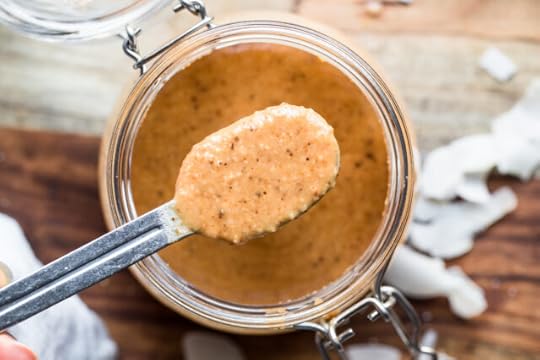 You probably already cook with coconut oil. Maybe you enjoy big flakes of toasted coconut in your trail mix or shredded coconut in your grain-free Primal “oatmeal.” But have you tried the richest, most decadent coconut product of them all: coconut butter?
You probably already cook with coconut oil. Maybe you enjoy big flakes of toasted coconut in your trail mix or shredded coconut in your grain-free Primal “oatmeal.” But have you tried the richest, most decadent coconut product of them all: coconut butter?
What is coconut butter, you ask? It’s simply dried coconut blended until it forms a smooth, creamy paste. Since the only ingredient is coconut, it’s naturally dairy-free and gluten-free.
Our favorite way to enjoy it is making the world’s easiest two-ingredient keto treat: dark chocolate with a schmear of coconut butter. Or just eat it with a spoon. We’ll never tell.
How to Make Coconut ButterServings: 1 to 2 cups
Time in the kitchen: 10 to 20 minutes
Ingredients4 or more cups of unsweetened, dried coconut flakes
DirectionsThere’s only one necessary step: blend!
But if you want to make the best coconut butter ever, follow these 10 no-fail tips.
10 Tips for Making the Best Coconut Butter EverTip #1: Use large unsweetened dried coconut flakes. These are easier to turn into butter.
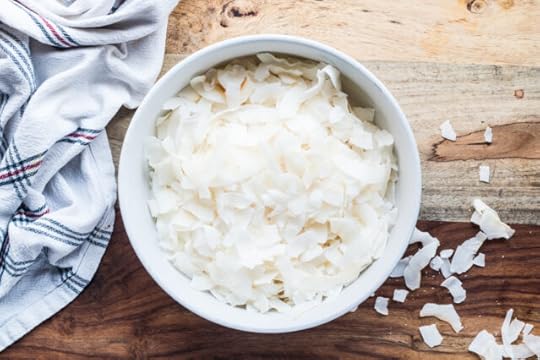
Tip #2: For a deeper, nuttier flavor, toast the coconut.
Lay the coconut out on a sheet pan and place in the oven at 300 degrees Fahrenheit (150 degrees Celsius) until the coconut is lightly brown and toasted. This elevates the flavor of the coconut butter, and it will also make it easier to turn the flakes into butter.
This is not a necessary step but if you have a weak food processor, it might be a better option. If you choose to toast the coconut, the final product will be light brown instead of white, as shown in the photos later in the post.

Tip #3: Use at least 4 cups of coconut flakes and place them into a food processor. You can also use a high-speed blender, but a food processor typically makes it easier to scrape down the sides and remove the coconut butter when it’s done processing. Blenders will make a somewhat smoother finished product, but some blenders will overheat before you’re done blending the coconut.
Tip #4: Take your time! It takes anywhere from 10 to 20 minutes to get a nice smooth butter.
Tip #5: Once you turn the food processor on and let it begin to grind the coconut, stop every so often to scrape the sides of the bowl with a spoon or spatula to pick up any flakes on the sides.

Tip #6: The coconut flakes will go through multiple transformations as it turns to butter. First they will look like coarse sand.
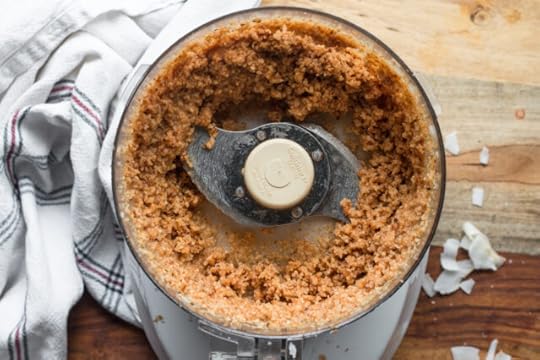
Next, it will become liquid-y but still look grainy.
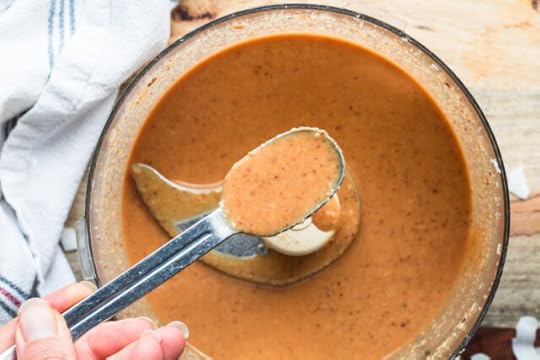
Last, it will be a smooth, thick sauce. The end result will still be thin, but it will firm up as you store it.
Tip #7: Pour the butter into an airtight jar and let it cool. Optionally, store it into multiple small containers, which makes it easier to warm up and use later on.
Tip #8: Coconut butter can be stored at room temperature, but keep in mind that toasted coconut butter will go rancid much more quickly than non-toasted. Consequently, we recommend storing toasted coconut butter in the fridge.
Tip #9: Coconut butter hardens at cooler temperatures. To use hardened butter, set up a warm water bath and let the jar sit in it for a few minutes to help soften the butter, stirring occasionally. We don’t recommend directly heating or microwaving the butter as this can mess with its consistency, but you can do it in a pinch!
Tip #10: Use the coconut butter for almost anything! We love dunking fruit or nuts in softened butter. Try adding a spoonful to savory options like curries, soups, or even to mashed veggies.
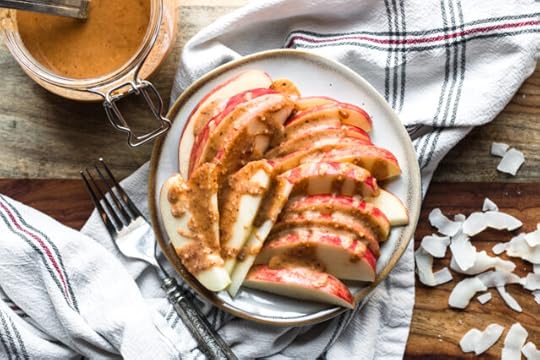

The post How to Make Coconut Better: 10 Tips for the Best Coconut Butter Ever appeared first on Mark's Daily Apple.


Mark Sisson's Blog
- Mark Sisson's profile
- 199 followers




